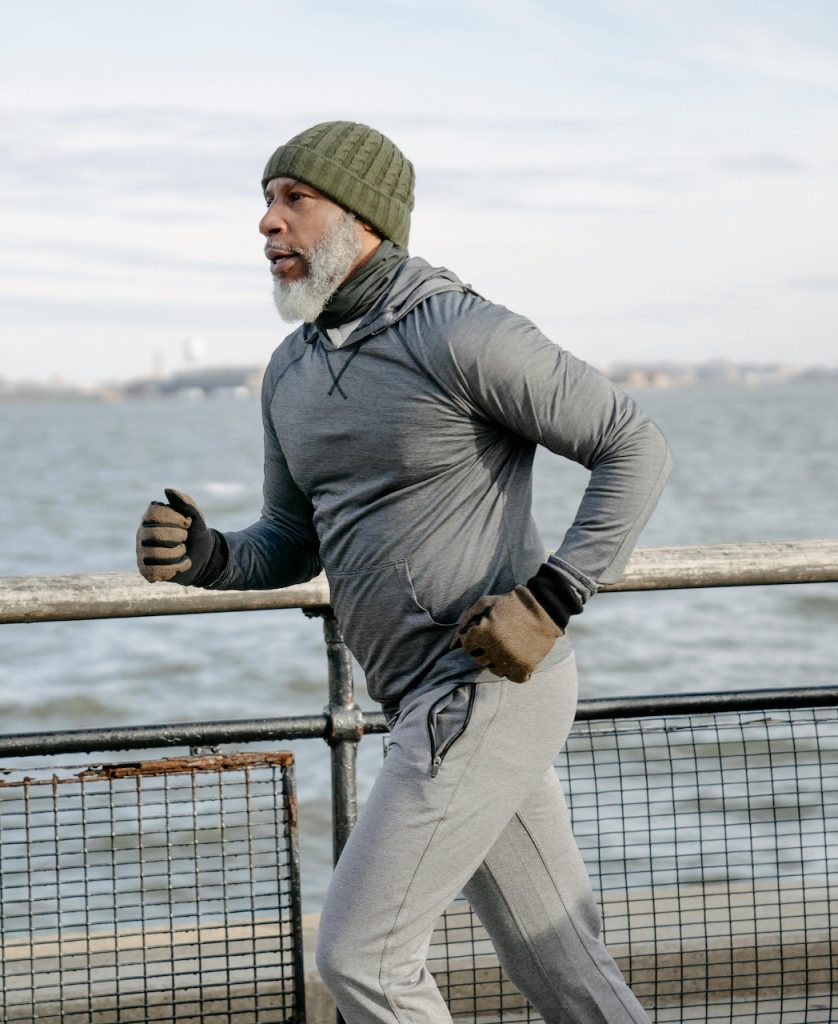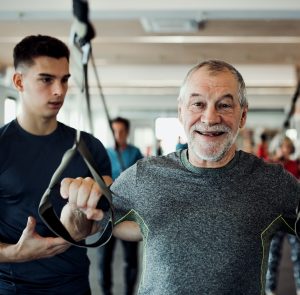Health tips
All movement is good movement: tips for exercising with prostate cancer
Being active has many benefits for men with prostate cancer, regardless of where you are on your cancer journey. Exercise can help to slow progression of localised cancer,1 reduce your risk of cardiovascular disease,2 relieve fatigue,3 and improve your physical, cognitive,4 and mental health.5
Intrigued? In this article, we describe evidence-based exercise guidelines for men with prostate cancer and we explore how much exercise might be right for you. We also outline some simple recommendations for integrating more activity in your day-to-day life and provide tips for staying motivated and developing a routine that you can stick with long-term.
How much exercise should I aim for with prostate cancer?
Everyone is different, so the ideal amount, type, and intensity of exercise for you is a personal choice. This will be influenced by your current state of fitness and your treatment journey so far. If you’re starting a new exercise routine, it’s important to listen to your body. Start small and take it step by step, building up your activity level gradually.
Current physical activity guidelines for people living with cancer recommend 150 minutes of moderate-intensity exercise (e.g. brisk walking) or 75 minutes of vigorous-intensity exercise (e.g. running) per week, with 2 or 3 additional resistance training sessions.6 As a general rule, moderate-intensity exercise should elevate your heart rate and breathing rate, but you should still be able to hold a conversation. Vigorous intensity exercise should make your heart rate and breathing rate increase substantially —at which point, your conversations might be limited to short bursts of just a handful of words.

What exercise should I take up?
The type of activity you choose is up to you. The key to getting active is to find activities that you enjoy and that fit into your lifestyle. Find something you like, and you’re more likely to stay motivated and keep doing it in the long term.
 Research suggests that regardless of what exercise you’re doing, supervised training is more effective than self-implemented routines.7,8 One of the benefits of exercising with support is the additional motivation it can bring. An instructor can also ensure you’re performing exercises with proper form and can help to tailor your training program to your specific needs and goals. So, if it’s an option for you, undertaking an exercise program with the support of an exercise physiologist, certified exercise instructor, or with a community program is strongly encouraged. Remember, you don’t need to have a professional by your side every time you exercise. If you have the opportunity, why not arrange a weekly support session, and exercise alone or with a companion for the rest of the week?
Research suggests that regardless of what exercise you’re doing, supervised training is more effective than self-implemented routines.7,8 One of the benefits of exercising with support is the additional motivation it can bring. An instructor can also ensure you’re performing exercises with proper form and can help to tailor your training program to your specific needs and goals. So, if it’s an option for you, undertaking an exercise program with the support of an exercise physiologist, certified exercise instructor, or with a community program is strongly encouraged. Remember, you don’t need to have a professional by your side every time you exercise. If you have the opportunity, why not arrange a weekly support session, and exercise alone or with a companion for the rest of the week?
While a supervised exercise routine using a combination of aerobic and resistance training is most highly recommended, any amount of activity is beneficial – even if it’s not considered as “exercise”. Increasing your day-to-day activity level and reducing the time you spend sitting down has numerous health benefits. Breaking up periods of sedentary activity with regular movements can help to activate your metabolism and burn more energy, helping you to maintain a healthier weight,9 putting you less at risk of cardiovascular disease, and increasing life expectancy.10 Even for those who are achieving the recommended exercise guidelines above, breaking up periods of inactivity is still recommended to reduce the health risks of a sedentary lifestyle.11
If you feel you don’t have time to fit an “exercise program” into your week, there are plenty of time-efficient ways you can incorporate more activity into your daily life. Why not try:
- Walking to the shops
- Commuting to work by foot or bike
- Getting off the bus one stop earlier
- Opting for the stairs instead of the elevator
- Getting moving by doing household chores, such as gardening or housework
- Taking a 15-minute walk during your lunch break or coffee break.
Should I exercise if I’m undergoing treatment for prostate cancer?
 If you are undergoing surgery to remove your prostate, gentle exercise is an excellent way to assist your recovery. Take it easy in the weeks after the operation to give your body the chance to recover. Gentle exercise, like taking walks every day, is a good way to rebuild strength while avoiding complications from being inactive, such as blood clots. To start with, try taking several 5–10-minute walks throughout the day, and gradually increase your daily activity level. It’s best to avoid impact sports, strenuous exercise, and heavy lifting for 6 weeks. Following your prostatectomy, it’s common to experience leaking urine (incontinence) due to the damage to the nerves and tissues around your prostate. Men who perform exercises to strengthen their pelvic floor before and after surgery tend to experience fewer urinary problems and recover continence faster than men who don’t perform these exercises.12 We advise talking to your physician for detailed and personalised recommendations to guide your recovery.
If you are undergoing surgery to remove your prostate, gentle exercise is an excellent way to assist your recovery. Take it easy in the weeks after the operation to give your body the chance to recover. Gentle exercise, like taking walks every day, is a good way to rebuild strength while avoiding complications from being inactive, such as blood clots. To start with, try taking several 5–10-minute walks throughout the day, and gradually increase your daily activity level. It’s best to avoid impact sports, strenuous exercise, and heavy lifting for 6 weeks. Following your prostatectomy, it’s common to experience leaking urine (incontinence) due to the damage to the nerves and tissues around your prostate. Men who perform exercises to strengthen their pelvic floor before and after surgery tend to experience fewer urinary problems and recover continence faster than men who don’t perform these exercises.12 We advise talking to your physician for detailed and personalised recommendations to guide your recovery.
If you are undergoing androgen deprivation therapy (hormone therapy) for your prostate cancer, exercise can help to manage treatment-related toxicities, which include increased risk of cardiovascular disease, reduced bone density, and reduced muscle mass. Regular exercise is considered well tolerated and safe, and is recommended to lessen the adverse effects of treatment.13 Consistent with the guidelines stated above, a supervised exercise program combining resistance and aerobic training is strongly recommended.7,8
If you are undergoing radiotherapy or chemotherapy, physical activity can have multiple benefits – particularly the reduction of fatigue. By moving your body frequently, you can maintain your fitness and shape better, and this can help to keep fatigue at bay. It’s highly recommended to break up periods of inactivity with regular movement, and to exercise more vigorously if you feel up to it.11 Depending on how you feel, that might just mean getting up to wander around the house. But if you feel up to it, there’s nothing to stop you doing more energetic aerobic or resistance training!

If you have bone metastases, balancing exercise recommendations against the increased risk of bone fractures can be a delicate task – however, this shouldn’t prevent exercise entirely. The risk of complications is highly personal and is affected by the characteristics of your bone metastases, your treatment journey and other personal factors. For many people with bone metastases, low-impact exercise can still be beneficial despite the increased risk of fractures, and can reduce treatment side effects, maintain fitness, and improve quality of life.14 We strongly recommend consulting with your care provider and a qualified exercise professional to assess your risk of skeletal complications, and to understand what kind of exercise is safe for you.
Our tips for staying motivated to exercise:
Getting started with a new routine, and finding the motivation to stick at it, can be a challenge. If you’re struggling to get started, here are some ideas that can help you stay on track:

- Make it social. Planning to work out with a friend or as part of a group means you’ll have people to hold you accountable to your plans. It’s also a great way to socialise and can motivate you to work harder.
- Schedule your activity. Research shows that people who set reminders to develop habits are more likely to follow through with their plans.15 Set a digital alert or add it to your calendar to act as a physical reminder to get up and get moving.
- Mix it up. Variety is the spice of life, and the same goes for exercise. Changing up your routine not only helps to prevent boredom but can also help to engage different muscle groups and different elements of fitness.
- Set yourself a goal. People who have a goal to work towards are more motivated to stay on track. Make it attainable, but enough of a challenge to require a committed effort. Good luck!
Information you can trust
With so many opinions out there, it can be hard to know who to follow. At Oncolifestyle we do our best to provide you with evidence-based information that has been carefully researched with your health in mind.
Our sources
Where is this information coming from?
Our sources
Where is this information coming from?
- Kang, D.-W. et al. Effects of Exercise on Cardiorespiratory Fitness and Biochemical Progression in Men With Localized Prostate Cancer Under Active Surveillance: The ERASE Randomized Clinical Trial. JAMA Oncol. 7, 1487 (2021).
- Nystoriak, M. A. & Bhatnagar, A. Cardiovascular Effects and Benefits of Exercise. Front. Cardiovasc. Med. 5, 135 (2018).
- Baguley, B., Bolam, K., Wright, O. & Skinner, T. The Effect of Nutrition Therapy and Exercise on Cancer-Related Fatigue and Quality of Life in Men with Prostate Cancer: A Systematic Review. Nutrients 9, 1003 (2017).
- Omura, J. D. et al. Cross-sectional association between physical activity level and subjective cognitive decline among US adults aged ≥45 years, 2015. Prev. Med. 141, 106279 (2020).
- Schuch, F. B. & Vancampfort, D. Physical activity, exercise, and mental disorders: it is time to move on. Trends Psychiatry Psychother. 43, 177–184 (2021).
- Hart, N. H., Galvão, D. A. & Newton, R. U. Exercise medicine for advanced prostate cancer. Curr. Opin. Support. Palliat. Care 11, 247–257 (2017).
- Kokorovic, A. et al. UPDATE – Canadian Urological Association guideline on androgen deprivation therapy: Adverse events and management strategies (Full-text). Can. Urol. Assoc. J. 16, E416-31 (2022).
- Mottet, N. et al. EAU Guidelines on Prostate Cancer. (EAU Guidelines Office, 2023).
- Healy, G. N. et al. Breaks in sedentary time: beneficial associations with metabolic risk. Diabetes Care 31, 661–666 (2008).
- Länsitie, M. et al. Cardiovascular disease risk and all-cause mortality associated with accelerometer-measured physical activity and sedentary time ‒ a prospective population-based study in older adults. BMC Geriatr. 22, 729 (2022).
- Neuzillet, C. Nutrition et activité physique en cancérologie (recommandations Françaises). FMC-HGE https://www.fmcgastro.org/texte-postu/postu-2023/nutrition-et-activite-physique-en-cancerologie-recommandations-francaises/.
- Tienforti, D. et al. Efficacy of an assisted low-intensity programme of perioperative pelvic floor muscle training in improving the recovery of continence after radical prostatectomy: a randomized controlled trial. BJU Int. 110, 1004–1010 (2012).
- Cagliari, M. et al. Feasibility and Safety of Physical Exercise to Preserve Bone Health in Men With Prostate Cancer Receiving Androgen Deprivation Therapy: A Systematic Review. Phys. Ther. 102, pzab288 (2022).
- Campbell, K. L. et al. Exercise Recommendation for People With Bone Metastases: Expert Consensus for Health Care Providers and Exercise Professionals. JCO Oncol. Pract. 18, e697–e709 (2022).
- Gollwitzer, P. Implementation Intentions: Strong Effects of Simple Plans. Am. Psychol. 54, 493–503 (1999).

